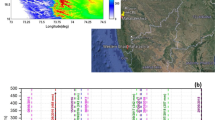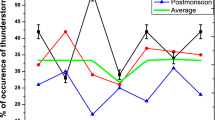Abstract
A wind profiler radar at 205 MHz is operational since January 2017, at Cochin (\(10.04^\circ \hbox {N}\); \(76.33^\circ \hbox {E}\)), a region lying in the west coast of Southern Peninsular India, which also is the entry point of the Indian summer monsoon. Using the radar wind profiles obtained during April to September, the detailed vertical structure of wind during the pre-monsoon and monsoon period was studied for the years 2017 and 2018. The gradual transition from pre-monsoon to monsoon season as manifested by the development of monsoon circulations in the lower and upper troposphere is well captured by the radar observations. Parameters which characterize the strength of monsoon circulations have been derived which are shown to be potential predictors for declaring the monsoon onset over Kerala in an objective manner. The monsoon circulation during the year 2018 was studied in detail in the backdrop of extreme heavy rainfall over Kerala. It is observed that there is an anomalous decrease in the core height, but with high core speed in the Low-level Jet stream (LLJ) during 2018 as compared to year 2017. Owing to this unique placement of LLJ, it can be concluded that intense orographic lifting could have played a role in causing heavy rainfall over Kerala in 2018. The transitions in LLJ prior to heavy rainfall over south-west coast are aptly captured by the radar observations which opens up the possibility of predicting heavy rainfall events through continuous monitoring of monsoon circulation using radar.













Similar content being viewed by others
References
Ananthakrishnan R, Soman MK (1988) The onset of the southwest monsoon over Kerala: 1901 1980. Int J Climatol 8:283–296. https://doi.org/10.1002/joc.3370080305
Anber U, Wang S, Sobel A (2014) Response of atmospheric convection to vertical wind shear: cloud-system-resolving simulations with parameterized large-scale circulation. part i: specified radiative cooling. J Atmos Sci 71:2976–2993. https://doi.org/10.1175/JAS-D-13-0320.1
Ashok K, Guan Z, Yamagata T (2001) Impact of the Indian Ocean dipole on the relationship between the Indian monsoon rainfall and ENSO. Geophys Res Lett 28:4499–4502. https://doi.org/10.1029/2001GL013294
Chen R, Tomassini L (2015) The role of moisture in summertime low-level jet formation and associated rainfall over the East Asian monsoon region. J Atmos Sci 72:3871–3890. https://doi.org/10.1175/JAS-D-15-0064.1
Chen TC, van Loon H (1987) Interannual variation of the tropical easterly jet. Mon Weather Rev 115:1739. https://doi.org/10.1175/1520-0493(1987)115<1739:IVOTTE>2.0.CO;2
Dee DP, Uppala SM, Simmons AJ, Berrisford P, Poli P, Kobayashi S, Andrae U, Balmaseda MA, Balsamo G, Bauer P, Bechtold P, Beljaars ACM, van de Berg L, Bidlot J, Bormann N, Delsol C, Dragani R, Fuentes M, Geer AJ, Haimberger L, Healy SB, Hersbach H, Hólm EV, Isaksen L, Kållberg P, Köhler M, Matricardi M, McNally AP, Monge-Sanz BM, Morcrette JJ, Park BK, Peubey C, de Rosnay P, Tavolato C, Thépaut JN, Vitart F (2011) The ERA-Interim reanalysis: configuration and performance of the data assimilation system. Q J R Meteorol Soc 137:553–597. https://doi.org/10.1002/qj.828
DelSole T, Shukla J (2012) Climate models produce skillful predictions of Indian summer monsoon rainfall. Geophys Res Lett 39:L09703. https://doi.org/10.1029/2012GL051279
Gadgil S, Vinayachandran PN, Francis PA, Gadgil S (2004) Extremes of the Indian summer monsoon rainfall, ENSO and equatorial Indian Ocean oscillation. Geophys Res Lett 31:L12213. https://doi.org/10.1029/2004GL019733
Goswami BN, Xavier PK (2005) ENSO control on the south Asian monsoon through the length of the rainy season. Geophys Res Lett 32:L18717. https://doi.org/10.1029/2005GL023216
Joseph PV, Sijikumar S (2004) Intraseasonal variability of the low-level jet stream of the Asian Summer Monsoon. J Clim 17:1449–1458. https://doi.org/10.1175/1520-0442(2004)017<1449:IVOTLJ>2.0.CO;2
Joseph PV, Sooraj KP, Rajan CK (2006) The summer monsoon onset process over South Asia and an objective method for the date of monsoon onset over Kerala. Int J Climatol 26:1871–1893. https://doi.org/10.1002/joc.1340
Kane RP (1998) Extremes of the ENSO phenomenon and Indian summer monsoon rainfall. Int J Climatol 18:775–791. https://doi.org/10.1002/(SICI)1097-0088(19980615)18:7<775::AID-JOC254>3.0.CO;2-D
Kottayil A, John V, Buehler S, Mohanakumar K (2016a) Evaluating the diurnal cycle of upper tropospheric humidity in two different climate models using satellite observations. Remote Sens 8:325. https://doi.org/10.3390/rs8040325
Kottayil A, Mohanakumar K, Samson T, Rebello R, Manoj MG, Varadarajan R, Santosh KR, Mohanan P, Vasudevan K (2016b) Validation of 205 MHz wind profiler radar located at Cochin, India, using radiosonde wind measurements. Radio Sci 51:106–117. https://doi.org/10.1002/2015RS005836
Kottayil A, Satheesan K, Mohankumar K, Chandran S, Samson T (2018) An investigation into the characteristics of inertia gravity waves in the upper troposphere/lower stratosphere using a 205 mhz wind profiling radar. Remote Sens Lett 9(3):284–293. https://doi.org/10.1080/2150704X.2017.1418991
Mitra AK, Momin IM, Rajagopal EN, Basu S, Rajeevan MN, Krishnamurti TN (2013) Gridded daily Indian monsoon rainfall for 14 seasons: merged TRMM and IMD gauge analyzed values. J Earth Syst Sci 122:1173–1182. https://doi.org/10.1007/s12040-013-0338-3
Mohanakumar K, Kottayil A, Anandan VK, Samson T, Thomas L, Satheesan K, Rebello R, Manoj MG, Varadarajan R, Santosh KR, Mohanan P, Vasudevan K (2017) Technical details of a novel wind profiler radar at 205 mhz. J Atmos Ocean Technol 34(12):2659–2671. https://doi.org/10.1175/JTECH-D-17-0051.1
Mohanakumar K, Santosh KR, Mohanan P, Vasudevan K, Manoj MG, Kottayil TSA, Rakesh V, Rebello R, Abhilash S (2018) A versatile 205 mhz stratosphere—troposphere radar at cochin—scientific applications. Curr Sci 114(12):2459–2466
Narayanan S, Kottayil A, Mohanakumar K (2016) Monsoon low-level jet over the gateway of Indian summer monsoon: a comparative study for two distinct monsoon years. Meteorol Atmos Phys. https://doi.org/10.1007/s00703-016-0459-8
Nithya K, Kottayil A, Mohanakumar K (2019) Determining the tropopause height from 205mhz stratosphere troposphere wind profiler radar and study the factors affecting its variability during monsoon. J Atmos Sol Terr Phys 182:79–84. https://doi.org/10.1016/j.jastp.2018.10.018
Pai DS, Nair RM (2009) Summer monsoon onset over Kerala: new definition and prediction. J Earth Syst Sci 118:123–135. https://doi.org/10.1007/s12040-009-0020-y
Pattanaik DR, Satyan V (2000) Fluctuations of Tropical Easterly Jet during contrasting monsoons over India: a GCM study. Meteorol Atmos Phys 75:51–60. https://doi.org/10.1007/s007030070015
Raju PVS, Mohanty UC, Bhatla R (2005) Onset characteristics of the southwest monsoon over india. Int J Climatol 25(2):167–182. https://doi.org/10.1002/joc.1121
Robe FR, Emanuel KA (2001) The effect of vertical wind shear on radiative-convective equilibrium states. J Atmos Sci 58:1427–1445. https://doi.org/10.1175/1520-0469(2001)058<1427:TEOVWS>2.0.CO;2
Samson TK, Kottayil A, Manoj MG, Binoy Babu B, Rakesh V, Rebello R, Vasudevan K, Mohanan P, Santosh KR, Mohankumar K (2016) Technical aspects of 205 MHz VHF mini wind profiler radar for tropospheric probing. IEEE Geosci Remote Sens Lett 13:1027–1031. https://doi.org/10.1109/LGRS.2016.2561965
Sathiyamoorthy V, Pal PK, Joshi PC (2007) Intraseasonal variability of the Tropical Easterly Jet. Meteorol Atmos Phys 96:305–316. https://doi.org/10.1007/s00703-006-0214-7
Sperber KR, Brankovic C, Déqué M, Frederiksen CS, Graham R, Kitoh A, Kobayashi C, Palmer T, Puri K, Tennant W, Volodin E (2001) Dynamical seasonal predictability of the Asian summer monsoon. Mon Weather Rev 129:2226. https://doi.org/10.1175/1520-0493(2001)129<2226:DSPOTA>2.0.CO;2
Waliser DE, Stern W, Schubert S, Lau KM (2003) Dynamic predictability of intraseasonal variability associated with the Asian summer monsoon. Q J R Meteorol Soc 129:2897–2925. https://doi.org/10.1256/qj.02.51
Walters D, Boutle I, Brooks M, Melvin T, Stratton R, Vosper S, Wells H, Williams K, Wood N, Allen T, Bushell A, Copsey D, Earnshaw P, Edwards J, Gross M, Hardiman S, Harris C, Heming J, Klingaman N, Levine R, Manners J, Martin G, Milton S, Mittermaier M, Morcrette C, Riddick T, Roberts M, Sanchez C, Selwood P, Stirling A, Smith C, Suri D, Tennant W, Vidale PL, Wilkinson J, Willett M, Woolnough S, Xavier P (2017) The met office unified model global atmosphere 6.0/6.1 and JULES global land 6.0/6.1 configurations. Geosci Model Dev 10:1487–1520. https://doi.org/10.5194/gmd-10-1487-2017
Wang B, Ding Q, Joseph PV (2009) Objective definition of the Indian summer monsoon onset*. J Clim 22:3303–3316. https://doi.org/10.1175/2008JCLI2675.1
Xavier A, Kottayil A, Mohanakumar K, Xavier PK (2018) The role of monsoon low-level jet in modulating heavy rainfall events. Int J Climatol 38:e569–e576. https://doi.org/10.1002/joc.5390
Xavier P, Rahmat R, Cheong WK, Wallace E (2014) Influence of Madden–Julian oscillation on Southeast Asia rainfall extremes: observations and predictability. Geophys Res Lett 41:4406–4412. https://doi.org/10.1002/2014GL060241
Xavier PK, Marzin C, Goswami BN (2007) An objective definition of the Indian summer monsoon season and a new perspective on the ENSO monsoon relationship. Q J R Meteorol Soc 133:749–764. https://doi.org/10.1002/qj.45
Acknowledgements
We sincerely acknowledge and thank the Science and Engineering Research Board (SERB), Department of Science and Technology (DST), Government of India, for providing the grant and for their assistance in the design and conception of the ST-radar facility at CUSAT. K. Mohanakumar would like to acknowledge the University Grants Commission for providing UGC BSR Faculty Fellowship.
Author information
Authors and Affiliations
Corresponding author
Additional information
Responsible Editor: A.-P. Dimri.
Publisher's Note
Springer Nature remains neutral with regard to jurisdictional claims in published maps and institutional affiliations.
Rights and permissions
About this article
Cite this article
Kottayil, A., Xavier, P., Satheesan, K. et al. Vertical structure and evolution of monsoon circulation as observed by 205-MHz wind profiler radar. Meteorol Atmos Phys 132, 531–545 (2020). https://doi.org/10.1007/s00703-019-00695-4
Received:
Accepted:
Published:
Issue Date:
DOI: https://doi.org/10.1007/s00703-019-00695-4




